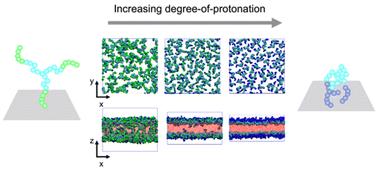Our official English website, www.x-mol.net, welcomes your
feedback! (Note: you will need to create a separate account there.)
Assembly of polyelectrolyte star block copolymers at the oil–water interface
Nanoscale ( IF 5.8 ) Pub Date : 2022-11-22 , DOI: 10.1039/d2nr05113c Jan-Michael Y Carrillo 1 , Zhan Chen 2 , Uvinduni I Premadasa 3 , Christian Steinmetz 2 , E Bryan Coughlin 2 , Benjamin Doughty 3 , Thomas P Russell 2, 4 , Bobby G Sumpter 1
Nanoscale ( IF 5.8 ) Pub Date : 2022-11-22 , DOI: 10.1039/d2nr05113c Jan-Michael Y Carrillo 1 , Zhan Chen 2 , Uvinduni I Premadasa 3 , Christian Steinmetz 2 , E Bryan Coughlin 2 , Benjamin Doughty 3 , Thomas P Russell 2, 4 , Bobby G Sumpter 1
Affiliation

|
To understand and resolve adsorption, reconfiguration, and equilibrium conformations of charged star copolymers, we carried out an integrated experimental and coarse-grained molecular dynamics simulation study of the assembly process at the oil–water interface. This is important to guide development of novel surfactants or amphiphiles for chemical transformations and separations. The star block copolymer consisted of arms that are comprised of hydrophilic–hydrophobic block copolymers that are covalently tethered via the hydrophobic blocks to one point. The hydrophobic core represents polystyrene (PS) chains, while the hydrophilic corona represents quaternized poly(2-vinylpyridine) (P2VP) chains. The P2VP is modeled to become protonated when in contact with an acidic aqueous phase, thereby massively increasing the hydrophilicity of this block, and changing the nature of the star at the oil–water interface. This results in a configurational change whereby the chains comprising the hydrophilic corona are significantly stretched into the aqueous phase, while the hydrophobic core remains solubilized in the oil phase. In the simulations, we followed the kinetics of the anchoring and assembly of the star block copolymer at the interface, monitoring the lateral assembly, and the subsequent reconfiguration of the star via changes in the interfacial tension that varies as the degree-of-protonation increases. At low fractions of protonation, the arm cannot fully partition into the aqueous side of the interface and instead interacts with other arms in the oil phase forming a network near the interface. These insights were used to interpret the non-monotonic dependence of pH with the asymptotic interfacial tension from pendant drop tensiometry experiments and spectral signatures of aromatic stretches seen in vibrational sum frequency generation (SFG) spectroscopy. We describe the relationship of interfacial tension to the star assembly via the Frumkin isotherm, which phenomenologically describes anti-cooperativity in adsorbing stars to the interface due to crowding. Although our model explicitly considers long-range electrostatics, the contribution of electrostatics to interfacial tension is small and brought about by strong counterion condensation at the interface. These results provide key insights into resolving the adsorption, reconfiguration, and equilibrium conformations of charged star block copolymers as surfactants.
中文翻译:

聚电解质星形嵌段共聚物在油水界面的组装
为了理解和解决带电星形共聚物的吸附、重构和平衡构象,我们对油水界面的组装过程进行了综合实验和粗粒度分子动力学模拟研究。这对于指导用于化学转化和分离的新型表面活性剂或两亲物的开发非常重要。星形嵌段共聚物由由亲水-疏水嵌段共聚物组成的臂组成,这些嵌段共聚物通过共价键连接疏水块到一点。疏水核心代表聚苯乙烯 (PS) 链,而亲水冠代表季铵化聚 (2-乙烯基吡啶) (P2VP) 链。P2VP 被建模为在与酸性水相接触时质子化,从而大大增加了该块的亲水性,并改变了油水界面处恒星的性质。这导致构型发生变化,由此构成亲水冠的链被显着拉伸到水相中,而疏水核心仍然溶解在油相中。在模拟中,我们跟踪了星形嵌段共聚物在界面处的锚定和组装动力学,监测横向组装,以及随后通过随着质子化程度的增加而变化的界面张力的变化。在低质子化分数下,臂不能完全划分到界面的水侧,而是与油相中的其他臂相互作用,在界面附近形成网络。这些见解用于解释 pH 值与悬滴张力测量实验中的渐近界面张力的非单调依赖性以及在振动和频生成 (SFG) 光谱中看到的芳香族伸展的光谱特征。我们通过以下方式描述界面张力与星形组件的关系Frumkin 等温线,它在现象学上描述了由于拥挤而将恒星吸附到界面的反协同性。尽管我们的模型明确考虑了长程静电,但静电对界面张力的贡献很小,并且是由界面处的强抗衡离子凝结引起的。这些结果为解析带电星形嵌段共聚物作为表面活性剂的吸附、重构和平衡构象提供了重要见解。
更新日期:2022-11-25
中文翻译:

聚电解质星形嵌段共聚物在油水界面的组装
为了理解和解决带电星形共聚物的吸附、重构和平衡构象,我们对油水界面的组装过程进行了综合实验和粗粒度分子动力学模拟研究。这对于指导用于化学转化和分离的新型表面活性剂或两亲物的开发非常重要。星形嵌段共聚物由由亲水-疏水嵌段共聚物组成的臂组成,这些嵌段共聚物通过共价键连接疏水块到一点。疏水核心代表聚苯乙烯 (PS) 链,而亲水冠代表季铵化聚 (2-乙烯基吡啶) (P2VP) 链。P2VP 被建模为在与酸性水相接触时质子化,从而大大增加了该块的亲水性,并改变了油水界面处恒星的性质。这导致构型发生变化,由此构成亲水冠的链被显着拉伸到水相中,而疏水核心仍然溶解在油相中。在模拟中,我们跟踪了星形嵌段共聚物在界面处的锚定和组装动力学,监测横向组装,以及随后通过随着质子化程度的增加而变化的界面张力的变化。在低质子化分数下,臂不能完全划分到界面的水侧,而是与油相中的其他臂相互作用,在界面附近形成网络。这些见解用于解释 pH 值与悬滴张力测量实验中的渐近界面张力的非单调依赖性以及在振动和频生成 (SFG) 光谱中看到的芳香族伸展的光谱特征。我们通过以下方式描述界面张力与星形组件的关系Frumkin 等温线,它在现象学上描述了由于拥挤而将恒星吸附到界面的反协同性。尽管我们的模型明确考虑了长程静电,但静电对界面张力的贡献很小,并且是由界面处的强抗衡离子凝结引起的。这些结果为解析带电星形嵌段共聚物作为表面活性剂的吸附、重构和平衡构象提供了重要见解。











































 京公网安备 11010802027423号
京公网安备 11010802027423号